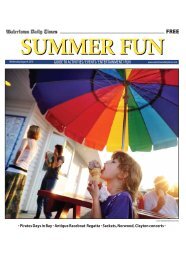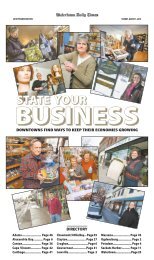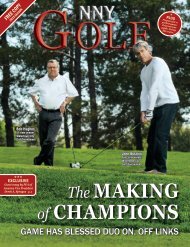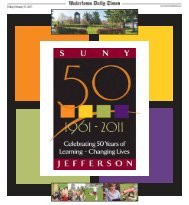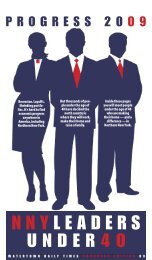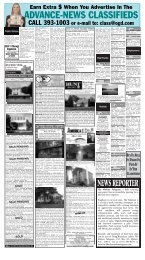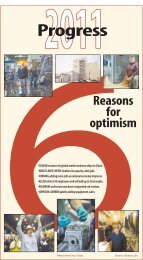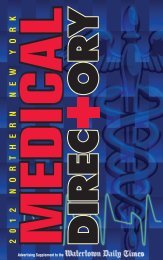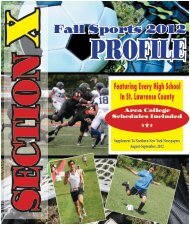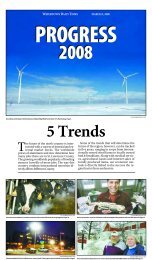Thursday, September 22, 2011 - Watertown Daily Times
Thursday, September 22, 2011 - Watertown Daily Times
Thursday, September 22, 2011 - Watertown Daily Times
Create successful ePaper yourself
Turn your PDF publications into a flip-book with our unique Google optimized e-Paper software.
C M Y K• 1 50 th A N N I VE R SAR Y • 18 6 1 - 2 0 1 1 •E4 <strong>Thursday</strong>, <strong>September</strong> <strong>22</strong>, <strong>2011</strong>WATERTOWN DAILY TIMESW A T E R T O W N1861 <strong>2011</strong>J OIN US FO R T H E N EXT 1 5 0 Y E A R SWD A I LY T I M E SRECOLLECTIONReporter got her startby stopping the pressesBy MARSHA DAVIS SPIRIDIGLIOZZIThere was the day I “stopped the presses” and theday I got to drive an M-1 Abrams Tank. One day wasa highlight of my nearly 25-year association with the<strong>Watertown</strong> <strong>Daily</strong> <strong>Times</strong>. The other ranksmuch lower.The war in Vietnam was ramping up when I joinedthe <strong>Times</strong> payroll in June 1965 as a proofreader in thecomposing room … a summer job after my freshmanyear at Jefferson Community College. A proofreader’sjob was to compare the type-set story or headline towhat the reporter or page editor hadsent out to the composing room tobe set in lead type, making sure thespelling and punctuation were accurate.While I’m sure the editor spelledit correctly, I did not see the typesetter’serror in what would be the frontpage banner headline for the day’sDavisSpiridigliozziRECOLLECTIONLearning journalismalong the St. LawrenceBy MIKE PELLATLANTA JOURNAL & CONSTITUTIONShortly after graduating from college I arrived in<strong>Watertown</strong> as a green reporter with little experienceoutside of my college newspaper.The <strong>Watertown</strong> <strong>Daily</strong> <strong>Times</strong> had just been featuredin a prominent journalism industry publication, Editorand Publisher, and came highly recommended asa solid newspaper for a young journalist to learn thecraft of reporting and writing.I started covering the ThousandsIslands beat, which included theCanadian border, the ThousandIslands Bridge Authority, environmentaland business issues relatedto the St. Lawrence River and everytown, village, and school districtPellboard meeting between Cape Vincentand Alexandria Bay. Thesewere heady times.The paper published my stories about how thepost 9-11 atmosphere affected northern border communities,including the first news account of federalregulations that would eventually require Americancitizens returning from Canada to carry passports.The paper documented how rules conceived in WashingtonD.C., would play out for American hockeymoms with kids in Canadian leagues and Canadianblue grass guitarists who had strummed at Americanfestivals for decades.Every winter I wrote about the St. Lawrence SeawayAuthority’s none-too-subtle attempts to edge up thestart of the shipping season, despite the fact that theywere unprepared for the oil or chemical spill thatcould accompany the grounding of a large vessel.During the summer I covered the water levels debatesin Clayton.And of course there were the hours of often bafflingconversation with Alexandria’s eccentric supervisor,F. Sampie Sutton. Say what you will, he got the roads,and sometimes even certain driveways, paved ontime.Perry White, then state editor and now city editor,helped develop my writing and reporting skills. He wasexactly the kind of editor all young reporters need. Heis interested, knowledgeable, ethical, gutsy and readyto let you know in no uncertain terms when you makea mistake. In the years following my departure from the<strong>Watertown</strong> <strong>Daily</strong> <strong>Times</strong>, I have worked with many editorsand can think of only a couple that are his equal.And I appreciated working for an editor like JohnB. Johnson Jr., who encouraged me to place ethicalstandards above all else and encouraged me to growas a reporter.Bob Gorman, managing editor, imparted the necessityof not getting too involved in a story and lettingthe facts speak for themselves.Taking my north country experiences with me Imoved on to the Center for Public Integrity, a nonprofit,nonpartisan, investigative news outfit in WashingtonD.C. where I worked for nearly three years.I now write about consumer issues like the sale ofpatient medical debt for the Atlanta Journal Constitution’sinvestigative team.final edition … something abouttroop movements in Vietnam. Itwas the day I learned that if the word“ever” shows up in MANEUVER… you’ve missed the error and it’s time to “stop thepresses.” Ooops!!I spent four proofreading summers between collegeyears at JCC and St. Lawrence University and duringthose years there were so many fulltime composingroom workers and summer staffers that us “summerkids” had to share time card slots with the veteranlinotype workers, typesetters and compositors. Thecompositors were the magicians who could somehowread lines of lead type that appeared upside downand backwards as they placed the galleys of type ontopage-size “trucks” in one of the many labor-intensivesteps of turning a reporter’s words and advertisingcopy into a newspaper “hot off the press.”The transformation of the bustling composingroom with its rows of clattering linotypes, each withtheir pots of molten lead, to the cleanliness of “coldtype” and now to computerized “pagination” marksthe amazing advances in newspaper production overSee Stopping, E6John Brayton Johnson was a 32-yearoldreporter and editorial writer, andsecretary of the Brockway Company,when in May 1949 his father’s suddendeath made him the editor and publisherof the <strong>Watertown</strong> <strong>Daily</strong> <strong>Times</strong>.The only son of the late publisher, JohnJohnson had graduated from Phillips ExeterAcademy in Exeter, N.H., and was apolitical science major at Princeton University,where he received a degree in 1939.Having performed the reporter’s toils at the<strong>Times</strong> during his college-year summers,he joined his father’s reportorial staff upongraduation and assumed the City Hall beat.The staff’s society editor at the time,Catherine A. Common, became JohnJohnson’s wife in June 1941. As the couplemarked their first wedding anniversary,the young journalist packed his bags togo serve his country. With the outbreak ofWorld War II, he enlisted in the Army, wascommissioned a second lieutenant, andwas assigned to counterintelligence in thePacific Order of Battle section in Washington,D.C.Following his December 1945 discharge,John Johnson returned to the <strong>Watertown</strong><strong>Daily</strong> <strong>Times</strong> to begin his 3 1/2 years’ preparationto take over the direction of thenewspaper.He inherited a seasoned newsroom staff,the majority of its members being <strong>Times</strong>’career people -- employees who would staywith the company until retirement, or evenuntil death.Harry F. Landon was in his 17th year asmanaging editor.“He provided that absolutely necessarycontinuity of management and leadershipto this newspaper when the new editor waslearning how and experiencing the difficultiesof the new assignments and the newproblems that were inevitable after HaroldB. Johnson’s death,” John Johnson wrote.“For five years he provided the assistancethat made it possible for an orderly transitionin management.”The assistant managing editor was WilliamE. Pearson, who had recently beenbrought in from the company’s Albanybureau. Gordon Bryant, having just completed17 years as city editor, had been withthe paper 33 years. That made him junioronly to David F. Lane, a veteran of 37 yearsin covering the courts.Alan S. Emory, with two years under hisbelt, was state editor, and 25-year veteranHoward A. Lennon was telegraph editor.John G. Case, popularly known as Jack, wasin his 29th year on the job, the last 20 assports editor.Flanking Mr. Lane on the veteran staffwere John H. Briar, brothers John andDominic Pepp, 19-year veteran FrederickH. Kimball, and Frank P. Augustine, whowas beginning his ninth year.Boyd W. Moffett, a company man since1934, was editing the Farm & Garden supplement,and respected book critic BeulahRector was in her 20th year as a <strong>Times</strong>’ contributor.Clark T. Morrison III, Oswego, and theonly woman reporter, Fauneil J. Rinn, wereFormer WDT staffers are working all over the countryA number of former <strong>Watertown</strong><strong>Daily</strong> <strong>Times</strong> reporters continue towork in journalism. They include:Scott D. Atkinson (1976) WWNY-TVPeter Barber (1987-2002) SchenectadyGazette photographerAmy Biancolli (1987) HoustonChonicle & Hearst Newspapers, musiccriticSteven Billmyer (1984-1986) SyracusePost Standard, team leaderRobert Brauchle (2006-2010) Utica ObserverDispatch reporterScott Bronstein (1994-2001) a news bloggerin PanamaTim Buckland (1998-2005) New HampshireUnion Leader reporterJohn Reed Coston (1971-1973) WallStreet JournalDawn Chmielewski(1986-1987) Los Angeles<strong>Times</strong>Matt Dorney (1989-1996) ColoradoSprings Gazette, copy editorShawn Dowd (1988-1994) AP WesternNew York bureau chief photographerDave Duprey (1990-1998) RochesterDemocrat and Chronicle photographerKeith Epstein (1980-1982) The HuffingtonPost Investigative FundLu R. Feorino (1985-1988) Springfield,Mass. Republican, city editorThomas S. Foster (1981-1984) GannettPaul S. Foy (1984-1990) Associated Press,New York’s youngest publisher in 1949,JOHN JOHNSONexpanded the <strong>Times</strong>’ reach for more than 53 yearsJohn and Catherine Johnson expanded the <strong>Times</strong>’ properties and also its support of NNY education,medical care and the arts.relative newcomers to the “city room.” Thepost of society editor was in transition,from Grace M. Ward to Barbara P. Smith.Mr. Johnson’s team also consisted ofmore than 20 correspondents and stringers,with Ernest G. Cook of Theresa beingthe senior man with his 47 years of writing.John Johnson strived to continue his father’sjournalistic philosophy, which he definedin an article marking the newspaper’s100th anniversary: expansion of news coverageso that the reader can get more newsout of one paper than he had previouslyobtained out of two, referring to a formercompetitor, the <strong>Watertown</strong> Standard.“That is why today the extra effort is alwaysmade for wide, detailed and completecoverage of the news,” Mr. Johnson wrote.Expansion of the printing press facilitiesof the <strong>Times</strong> was an expression of that philosophy,he said. His father had made plansfor a new building, and had purchased twopieces of property at the northwest cornerof Washington and Clinton streets.On one of the sites was a building erectedin 1811 to be a school, but used as a hospitalduring the War of 1812. The structurewas subsequently a seminary for girls, andeventually a residence. When the historicbuilding was bought in 1944 and scheduledfor demolition, Harold Johnson said in aneditorial, “The <strong>Times</strong> makes the purchasesimply to be prepared for necessary expansionsome time in the future.... The <strong>Times</strong>has felt for some time that it should takesome step to insure a location for a newhome eventually.”John Johnson ordered in 1950 an expansionof the printing plant on Arcade Street. Anaddition to the press gave the company theability to print a 40-page edition, increasingby eight pages the previous capacity.AlbanyKarenna Glover(1997-1999) Roanoke(Va.) <strong>Times</strong>John T. Golden(1983-2007) WestchesterCounty BusinessJournalA. Charles Haeffner(1970-1979) The GloverOdessa File, editorJacob Hannah (2006-2008) Lincoln, Neb.Star, photographerVernon Hill (1981-1987) Springfield,Mass. Republican, sports editorJeff Horseman (1999-2000) Riverside,Calif., Press-Enterprise, reporterJay Jochnowitz (1984-1987) Albany<strong>Times</strong> Union, editorial writerJames C. Kevlin (1980-1989) Freeman’sJournal, Cooperstown, publisherMaria Kinsley (2007-2010) Utica ObserverDispatchMargaret Kissinger (1979-1981) MilwaukeeJournalAlison Laurio (2006-<strong>2011</strong>) WinchesterStar, Va.Ken Lovett (1988-1992) New York <strong>Daily</strong>NewsThomas J. Martello (1980-1985) The StarLedger, Newark, N.J., bureau chiefCharlotte McAttee (1986-1988) Springfield,Mass. Republican, production editorGoldenStill bearing the name of the <strong>Times</strong>’founder, the Brockway Company decidedin 1954 to expand its radio holdings intothat new miracle called television, furtherdelaying construction of a new office building.The expansion, John Johnson reasoned,was “good judgment.”“The electronic industry moves fasterthan the printing industry. People like theirnews from their newspapers; they like theirnews from radio and television, but theylike also to be entertained, and the very natureof newspapers, their concept and theirlimitations, prevent them from being verysuccessful as entertainment devices.”So the newspaper continued to functionin a building erected for the New York <strong>Daily</strong>Reformer in 1861, to which had been addedby purchase in 1921 of the Ehrlicher building,adjoined to the north.The first floor housed the press, with theeditorial and composing departments occupyingthe second floor.In its last years of use, the old building’sthird floor lodged the photography unitand a private print shop.“The present home of the <strong>Times</strong> is comfortableand commodious,” Harold Johnsonhad said.“This old building is a homelike place. Itis warm in winter and it is seldom that thereis a day in summer when it is not cool. It isa kindly, hospitable building. To be sure, itis cut up.”But the old building, at 118-132 ArcadeSt., needed constant repair. The floorswere feared unsafe for the weight they hadto support. And certainly, it seemed, thestructure was becoming a fire trap.See Johnson E7Heather McCrea (1999-2002) OrangeCounty, Calif. Register, city editorRandy McMullen (1979-1984) Contracosta,Calif., <strong>Times</strong>William Moore (2006-2007) ArkansasDemocrat GazetteCory Nealon (2004-2007) NewportNews, Va., <strong>Daily</strong> PressMike Pell (2002-2006) Atlanta, Ga.,Journal ConstitutionRalph J. Perkins (1984-1988) SyracusePost Standard, neighbors editorKate Pickert (2001-2002) Time MagazineKaren Pominville (1994-1998) Bangor,Me. <strong>Daily</strong> News, PhotographerGeorge Spohr (2010-<strong>2011</strong>) The World,Coos Bay, Ore.Richard Sullivan (1979-1984) SyracusePost Standard, managing editor.Bob Sutton (1988-1995) Burlington, N.C.<strong>Times</strong> News sports editorKen Tysiac (1993-1995) Charlotte, N.C.Observer, sportsAmanda Voisard (2003-2006) WashingtonPost, photographerGene Warnick (1996-1997) Los Angeles<strong>Daily</strong> News sports editorDennis Watkins (2004-2005) freelancemagazine writerCarl Weiser (1986-1987) Cincinnati Inquirer,reporterCollen White (2006-2010) North JerseyMedia Group, photographer



